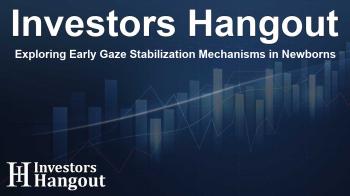Exploring Early Gaze Stabilization Mechanisms in Newborns

Understanding the Brain Circuit for Gaze Stabilization
Recent research has unveiled a fascinating aspect of brain development in newborns, especially concerning how they stabilize their gaze as they interact with their environment. This intricate process involves an ancient brain circuit that allows for immediate eye adjustments in response to body movement. Such discoveries pave the way for future studies aimed at understanding balance disorders and eye movement issues.
The Vestibulo-Ocular Reflex Explained
At the heart of this research is a crucial mechanism known as the vestibulo-ocular reflex. This reflex allows animals, including humans, to maintain a stable perception of their surroundings, even when their bodies tilt. If this system falters due to injury or genetic conditions, individuals can experience disorienting sensations, where the world appears to jump or sway with every head or body movement.
How Researchers Conducted Their Study
Led by talented researchers at a prominent medical school, the study focused on zebrafish larvae, which exhibit similar gaze stabilization reflexes to humans. The transparent nature of these larvae enabled scientists to observe neuron maturation in real-time as these young fish learned to properly adjust their eye positioning due to changes in their body orientation.
Surprising Findings on Reflex Development
The study, which was published in a renowned scientific journal, brought forth surprising information. Unlike previously believed, the researchers found that sensory input from visual stimuli was not a prerequisite for the development of the reflex circuit in newborns. This revelation suggests that the ability to stabilize gaze based on body movement finds a different developmental path in early life.
Innovative Testing Methods
To challenge long-held assumptions about the role of visual feedback in this reflex, the research team devised an innovative experimental setup. By assessing the reflex responses in zebrafish that were blind from birth, they discovered that these fish could reflexively counteract body tilts just like their sighted counterparts.
Identifying the Rate-Limiting Factors in Maturation
A striking outcome of this research was the determination that the maturation of the vestibulo-ocular reflex does not entirely depend on feedback from sensory organs. In their quest to identify the essential components of this circuit, researchers measured how brain and motor neurons responded throughout development. They discovered that certain parts of the circuit matured at differing speeds.
Neuromuscular Junction Insights
The researchers noted that the neuromuscular junction—a critical area where motor neurons communicate with muscle cells—was the last part to mature compared to the brain regions involved in the reflex. This insight points to a shift in how scientists understand the networks responsible for eye movements, highlighting the importance of the intersections between neural activity and muscle response.
Future Directions: Addressing Human Disorders
The journey does not end here; the research team's ongoing endeavors aim to connect their findings with human conditions. They plan to delve into how dysfunctions in motor neuron development relate to common ocular disorders, such as strabismus, where the eyes do not properly align.
Potential Impact on Children's Health
The goal of this research is far-reaching. By enhancing our understanding of how vestibular circuits develop, findings could eventually lead to improved therapeutic strategies for addressing balance disorders that affect a notable percentage of children. Ongoing investigations will prioritize discovering how disruptions in sensory processing can lead to broader issues, equipping healthcare professionals with the knowledge to aid affected children more effectively.
About the Research Community
The team behind this pivotal research consists of various experts contributing to the fields of otolaryngology, neuroscience, and physiology. Their comprehensive work shines a light on the complexity of brain and motor systems, enhancing our understanding of human health.
Frequently Asked Questions
What is the vestibulo-ocular reflex?
The vestibulo-ocular reflex is a mechanism that allows the eyes to stabilize images during head and body movements, ensuring a clear visual field.
Why was the study conducted on zebrafish?
Zebrafish are ideal for such studies due to their optical transparency, allowing researchers to observe neuron development and reflex maturation directly.
What did the findings suggest about reflex maturation in newborns?
The findings indicate that newborns can develop reflexes without reliance on sensory feedback, challenging previous assumptions.
How might this research affect balance disorders?
This research could lead to new treatments for balance disorders by providing insights into how related brain systems function and develop.
Who led the research study?
The research was led by a team of experts from a prestigious medical institution, focusing on the intersection of neurology and physiological development.
About The Author
Contact Evelyn Baker privately here. Or send an email with ATTN: Evelyn Baker as the subject to contact@investorshangout.com.
About Investors Hangout
Investors Hangout is a leading online stock forum for financial discussion and learning, offering a wide range of free tools and resources. It draws in traders of all levels, who exchange market knowledge, investigate trading tactics, and keep an eye on industry developments in real time. Featuring financial articles, stock message boards, quotes, charts, company profiles, and live news updates. Through cooperative learning and a wealth of informational resources, it helps users from novices creating their first portfolios to experts honing their techniques. Join Investors Hangout today: https://investorshangout.com/
The content of this article is based on factual, publicly available information and does not represent legal, financial, or investment advice. Investors Hangout does not offer financial advice, and the author is not a licensed financial advisor. Consult a qualified advisor before making any financial or investment decisions based on this article. This article should not be considered advice to purchase, sell, or hold any securities or other investments. If any of the material provided here is inaccurate, please contact us for corrections.

